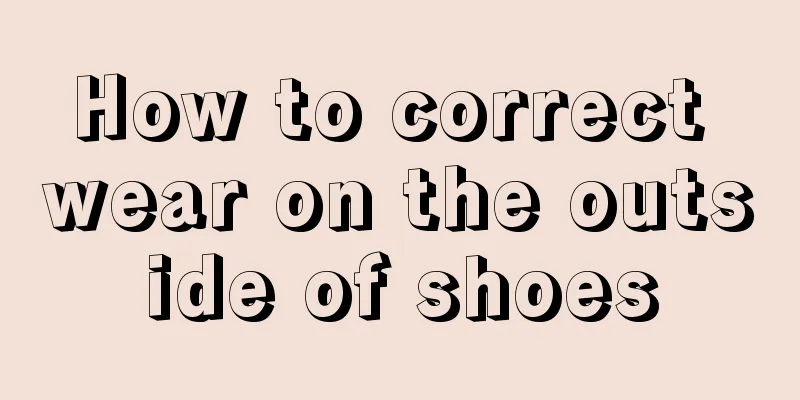How to correct wear on the outside of shoes

|
Whether our feet are normal can be confirmed by the wear and tear of our shoes. Some people's shoes are worn on both sides, and some people's shoes are worn on the heels. Although it is not a very serious phenomenon, long-term wear and tear will hurt our feet and the service life of the shoes will be greatly reduced. Depending on the different situations, different measures need to be taken for correction. So, how do you correct the wear on the outside of your shoes? Let’s take a look below. Wear on the outside of shoes is generally caused by the following three situations 1. Pathological reasons. Pathological causes of wear on the outside of shoes: If the outside of the heel of a newly bought pair of shoes wears out not long after being worn, it may be related to knee joint disease. The more severe the wear on the outside of the heel, the higher the risk of developing knee osteoarthritis. This is because as people age, the inner side of the knee joint space becomes narrower and the weight-bearing surface gradually changes, gradually damaging the knee joint; and because the heavier the body weight, the greater the pressure on the joint, which increases the load on the joint. Therefore, when you suffer from osteoarthritis of the knee, the wear on the outside of the heel will definitely be very serious. 2. Physiological reasons. Physiological reasons for wear on the outside of shoes: Some people have legs of different lengths, which will cause different wear on the outside of the heels. A curvature of the spine can also cause wear on the outside of the heel. 3. Walking posture. Reasons for walking posture with wear on the outside of the shoe: If the outside of the sole is severely worn, it may be that the calf is bent outward. This way of walking can easily lead to joint sprains and injuries. Long-term uneven force can also cause wear of the outer cartilage of the knee and cause arthritis. "This walking style puts pressure on the hip bones, leading to long-term pain in the bones when sitting, commonly known as bow legs." Treatment of pathological causes of lateral shoe wear 1. Treatment strategy: The key to treating knee arthritis is to prevent further wear of the cartilage. Choose drug treatment, arthroscopic treatment, physical therapy, etc. as appropriate. 2. General treatment: Avoid staying in one posture for a long time, and do not repeatedly flex and extend the knee joint or massage the patella; pay attention to prevent cold and dampness, keep warm, and avoid excessive fatigue of the knee joint; try to reduce exercises that cause the knee joint to flex and bear weight, such as going up and down stairs, to reduce wear of the articular cartilage. 3. Drug treatment: Chondroprotective agents such as glucosamine sulfate can promote the synthesis of cartilage, inhibit the decomposition of articular cartilage, and also have anti-inflammatory effects. The sulfate group rich in glucosamine sulfate is also one of the essential components for the synthesis of cartilage matrix. This type of drug can relieve pain symptoms, improve joint function, and long-term use can also delay the destruction of joint structure. Glucosamine sulfate takes a long time to take effect, but it has good safety and is suitable for long-term use as a basic treatment. 4. Arthroscopic treatment: A 5mm diameter rod-shaped optical endoscope is inserted into the joint cavity through the joint space, and the lesion site and tissue are magnified 4 to 6 times and displayed on the monitor. Tiny tools are used to repair the articular cartilage and clean the joint cavity. 5. Daily care: Prevent cold, fatigue, moisture, and wind, such as wearing thin knee pads, not riding electric bikes, not going to very humid places, etc. Avoid walking with weight, do not do extreme flexion and squatting, and move step by step when going up and down the stairs, and you can even walk sideways. 6. Dietary conditioning: Eat more foods rich in antioxidants, such as foods containing vitamin A and carotenoids, vitamin C, vitamin E, selenium, etc. Foods containing flavonoids: You can eat more citrus fruits, strawberries and other colorful fresh vegetables. Foods containing calcium: Milk is the best source of calcium. Treatment of physiological causes of lateral shoe wear 1. The two legs are not the same length: The unequal length of the lower limbs is quite common in clinical practice, and there are many diseases that lead to this phenomenon, such as premature epiphyseal closure, congenital hip dislocation, overlapping healing of lower limb fractures, bone and joint tuberculosis, and sequelae of polio. The basic causes of unequal length of the lower limbs include incomplete development of the long bones of the lower limbs or fracture, shortening and displacement resulting in different lengths; it can also be caused by congenital or acquired diseases of the hip joint, such as congenital hip dysplasia leading to congenital hip dislocation, femoral head necrosis and collapse, femoral neck fracture or intertrochanteric fracture; furthermore, tuberculosis, tumor or infection destroys the bones, causing them to lose their original length. Since there are many diseases that cause unequal length of lower limbs, the treatment varies according to the disease. For those acute injuries such as traumatic hip dislocation, femoral trochanter fracture, femoral and tibia and fibula fractures that cause shortening deformity, the shortening can be corrected as long as early reduction and fixation are performed as soon as possible. For some patients with ischemic necrosis, late-stage rheumatoid arthritis or late-stage infection, joint contracture deformity, bone necrosis movement disorders, etc., surgical treatment can be given, and artificial joint replacement can be performed to correct joint deformities and thus correct the unequal length of the lower limbs. As for the underdevelopment of long bones such as the femur, tibia and fibula, and shortening deformity after fracture, if the degree is mild and the difference in length of the two lower limbs is small, orthopedic shoes can be used to correct it. If the degree is more serious, bone lengthening surgery on the affected limb or osteotomy on the healthy side can be considered. The latter requires destruction of normal tissue and is therefore rarely used, while the former has certain limitations because the length of the surrounding blood vessels and nerves is well known. It can be seen that not every type of lower limb length discrepancy can be corrected. Similarly, surgical correction is generally not recommended during the active stages of certain tuberculosis, tumors, and infections to prevent the spread of bacteria or tumor cells throughout the body. 2. Spinal curvature: ① Manual reduction: It can peel off ligament adhesion, improve muscle nutrition, strengthen muscle metabolism, and enhance muscle elasticity. It can dredge meridians, improve blood circulation, and soften soft tissues and ligaments. ② Traction: It can increase the space between vertebrae and separate the adhesion tissues, thus achieving the purpose of reduction. ③ Brace fixation: After traction, use necessary braces to force the repositioned spine to remain stable and unchanged without retraction, and also have the effect of expanding the intervertebral space. ④Electrotherapy: Electromagnetic therapy is used to increase the absorption function of the lesion site, improve blood circulation, peel off tissue adhesions and prevent re-adhesion. ⑤Medication: According to different conditions and patient constitutions, different drugs and dosages are used to assist in the treatment. Correction of walking posture caused by wear on the outside of shoes First of all, individuals should develop good walking habits, overcome their past bad walking ways, and try to walk from the heel to the sole of the foot. This can balance the force surface of the shoe and greatly reduce the wear of the shoe. This will not only develop a good walking habit, but also maintain a good posture. Why not do it? But if you really cannot change your walking habits, you can solve the problem by gluing soles to your shoes. It is best to find a shoe repairman to put soles on the soles of your newly bought shoes. This way you don’t have to worry about them getting worn out when you walk. It doesn’t matter if the soles are worn out. You can continue to replace the soles as long as the soles of the shoes themselves are not damaged (this method is applicable to leather shoes and casual shoes. It is not very applicable to sports shoes). Also, it is best to have two or three pairs of shoes to wear backwards, as shoes also need rest. If you walk frequently, you should choose flat and smooth surfaces to walk on, which will not easily wear out the soles of your shoes. If you walk on the marble floors in shopping malls or subway stations, the soles of your shoes will be least likely to wear out. In the future, when choosing shoes, you should not only consider the appearance, but also pay more attention to the material of the sole, and try to choose shoes with moderate hardness and thicker soles. |
<<: Why doesn't the turtle open its eyes?
Recommend
Is postpartum curettage painful?
Giving birth is a very painful thing. Some women ...
Who is suitable for foot soaking with mugwort leaves
Generally speaking, people with yang deficiency a...
Treatment of immune thyroiditis
The treatment of immune thyroiditis should be car...
What should I do if I get tired easily while studying?
Many of my friends feel particularly tired when t...
Several common examination methods for small cell lung cancer
What are some common examination methods for smal...
What viruses and bacteria are ineffective when boiled in water?
High temperature can kill viruses and bacteria. E...
Pink foamy sputum
Pink frothy phlegm is a common health problem and...
Reasons for poor sense of balance
Some people are born with a great sense of balanc...
Is lettuce bitter and poisonous
Lettuce is a kind of green vegetable rich in vari...
What anti-inflammatory medicine should I use for swollen eyes
There are many reasons for swollen eyes. It may b...
Men should be alert to the possibility of liver cancer if they have the following symptoms
Do you know about liver cancer? In life, there ar...
General survival period of colon cancer liver metastasis
The general survival period of patients with live...
How to clean crabs
Crabs are delicious and nutritious, and are a fav...
Drink more water after doing these things
As we all know, life cannot live without water. E...
What kind of water should I use for skin allergies
Skin allergies are common diseases in daily life....









